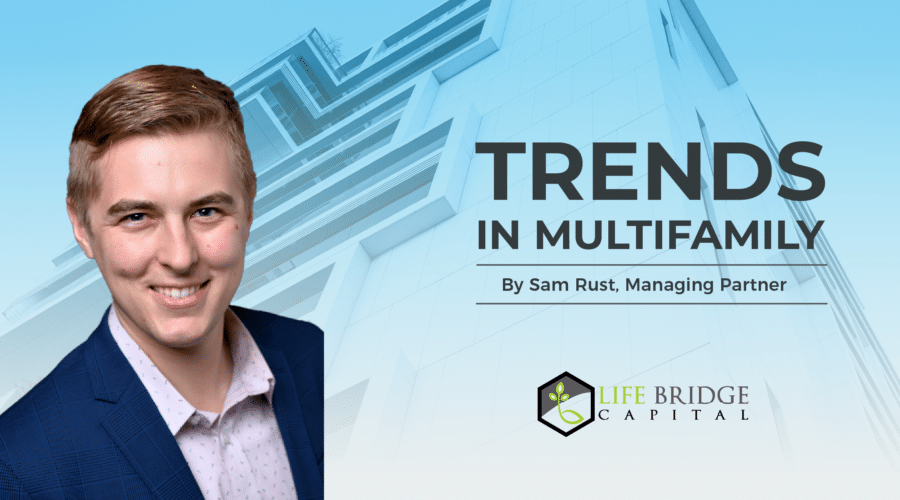So, you want to become a passive investor but don’t know how and where to start? Or perhaps you’ve invested in a deal already but want to get better at it. Yes, passive investing can be a “set it and forget it” type of investment where you hand over your capital, sit back, and enjoy the flow of passive income. Or you can choose to be more proficient by having a deeper understanding of certain aspects of syndication deals so that you can make smarter decisions that can lead to higher returns.
This is the topic in my recent conversation with James Kandasamy, multifamily syndicator and author of the book, “Passive Investing in Commercial Real Estate”. “My goal has always been to make the passive investor a more advanced investor because once you become a more sophisticated passive investor you can unlock more wealth,” he says. I’d like to share some of his ideas in this blog to help you understand passive investing and evaluating deals better so that you’ll be able to confidently compare potential investment opportunities and achieve more success with your investing goals. Listen to our full conversation here.
Here are some key factors to consider when getting into passive investing.
#1 Types of Passive Investment Deals
To get the most out of your investment, you need to learn how to review and compare syndication deals effectively. Below are the types of deals that James categorized based on the property, the returns, equity appreciation, and risks involved.
Core/Yield or Cash Flow Deal
- Focus on stabilized properties with an occupancy rate of at least eighty percent (80%) for a period of not less than one (1) full calendar quarter
- Cash flow focus (brings in cash flow from day 1)
- Minimum equity appreciation
- Risk: low
Value Add Deal
- Focus on light rehab property and operational improvements
- Cash flow after stabilization
- Medium equity appreciation
- Risk: medium
Deep Value Add Deal
- Focus on heavy-rehab property and operational improvements
- Cash flow after 1 to 3 years
- High equity appreciation
- Risk: high
#2 What Passive Investment Deal Is Best For You?
James reminds passive investors to choose a deal that best matches their own goals in life. So, what’s best for you largely depends on where you are in your investment cycle. Here’s how to do it: set your financial goals, look at what you are earning right now and how much you are willing to invest, assess how much risk you’re willing to take, and then identify which deal type can help you achieve your goals.
For example, let’s say you are on the latter part of your investment cycle. Because you are no longer working or are close to the age of retirement, your goal is to have a steady cash flow coming in that will allow you to enjoy your retirement. However, you do not want a lot of risk with your investment, so you will focus more on core/yield type deals that give cash-on-cash returns every month. This will help you achieve your goal of retiring without worrying that you’re going to lose your money.
If you are a professional with a W2 job, earning a substantial regular income, and not retiring in the next 20 or 30 years, your goal is to multiply and build your capital so that when you do get to that point, you’ll be set up well. So, you will want to focus more on value-add or deep-value-add deals that don’t pay a lot of cash flow upfront but have higher equity appreciation after the hold period. “Value-add investors focus more on capital, equity appreciation, or equity multiplication and can take more risk because they have their own full-time job to back them up,” says James.
James calls the middle ground, a combination of the core deal and the value-add deal, the hybrid. You get a little cash flow upfront, and later on, a regular cash flow. This is coupled with higher equity appreciation but slightly higher risk than core assets.
“There are a lot of sophisticated passive investors out there who are using all the strategies, but it is not very well taught to regular investors, especially to people who are jumping into syndication,” adds James.
#3 Passive Investment Returns
Cash-on-Cash
Cash-on-cash return measures the amount of cash flow relative to the amount of cash invested in a property – typically for a period of one year rather than for the life of the investment or project. James says this is the best indicator for core/yield type of deals, so investors preferring cash flow should focus on this metric. It is also the easiest and the most conservative way of measuring returns.
Annualized Return
The annualized return is the average of annual returns of each year over the investment period. It is useful when you want to see the performance of an investment over time or to compare two investments with different time periods. It essentially looks at the cash flow and the back-end sale/refinance of the asset.
Equity Multiple
In syndications, the equity multiple is the total cash distributions received from an investment, divided by the total capital or equity invested. It measures the total returns over the entire holding period in comparison to the cash you invested. An equity multiple higher than 1.0x means you are getting back more cash than you put in, so a 2x over a projected hold time of 5 years indicates that you could expect to double your money during that 5 years.
Internal Rate of Return (IRR)
James considers this as the best metric for value-add investors and for deal comparisons. If you’re interested in consistent cash distributions over the holding period and want the time value of money included in your computations, you should look into the IRR, advises James. Comparing IRR across your investment opportunities is one way you can check whether you’re getting a good return on your investment capital.
Risk-Adjusted Returns
James also discussed risk-adjusted returns, which are used by sophisticated investors as a more accurate way to compare and analyze a real estate investment because this metric considers the risk as it relates to its return.
“If there’s more cash flow, your risk in that deal is lower. Your return is higher because you’re focused on the cash flow which is higher value especially if you’re paid out first even if you have to give up something on the back end. Whereas if your cash flow is lower and you focus on your big money coming on in the back end, that risk is higher because you have to count years before that happens, making the return essentially low. Because, I mean, even though you get a lot more money at the back end, you’re facing higher risk,” explains James.
He summarizes, “IRR is important. Equity multiple is important, cash on cash, absolutely important, but I think when you partition the IRR into two different portions of the investment, that becomes a super sophisticated method for passive investors.”
#4 Deal Sponsor
The key factor that James considers the most important of all is the deal sponsor. James says: “More than finding the best proforma (which are projections of the property’s potential income and hence, can change), the more crucial question for a passive investor to answer is: How do I find a deal sponsor I can trust?”
The deal sponsor, the one who will control and manage your investment capital, is the only constant in your deal. So, before investing in any deal, you’ll want to evaluate the sponsor on the following points:
Experience and track record
Check their track record of success in similar past deals. Ask to see evidence of consistent returns over time and improvements in operational cash flow over time. Review deal history in detail. A reputed syndicator should be able not only to share financial information about the deal but will let you visit their properties, and allow you to study the books.
Background check
You can do a Google or social media search (Facebook or LinkedIn) for profiles and references, press mentions, and any other significant information that can give you an idea about their background and experience. Ask for the sponsor’s bio and resume to check skills and competencies.
You may also ask about the sponsor’s team – legal team, property management team, loan broker, loan provider, etc.
Ask for references from passive investors who had previously invested with the sponsor. Have they invested with this person more than once? Ask about the sponsor’s timely communication, trustworthiness, transparency, integrity, honesty, and whether they hit the projected returns.
Co-Investment
While not required, it would be a good trust-builder to know that the sponsor puts their own capital into the deal alongside you, to ensure that your interests are aligned. This shows the sponsor’s true confidence in the deal’s good performance.
FINAL THOUGHTS
As a passive investor, you enter into a relationship business when you choose to go into multifamily syndication. With your knowledge and due diligence, you will be able to find a deal suitable for helping you achieve your financial goals. More importantly, you can find a deal sponsor with whom you can build a long-term business relationship built on integrity, trust, and transparency who will work alongside you towards these same goals.
–
Got any questions? We are here to give you resources and information so that you can make smarter investment decisions. Send an email to [email protected] and let us help you.


